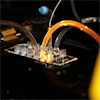| Apr 04, 2022 |
|
(Nanowerk News) In search of pharmaceutical agents such as new vaccines, industry will routinely scan thousands of related candidate molecules. A novel technique allows this to take place on the nano scale, minimizing use of materials and energy.
|
|
The work is published in Nature Chemistry (“Single-particle combinatorial multiplexed liposome fusion mediated by DNA”).
|
|
More than 40,000 different molecules can be synthesized and analyzed within an area smaller than a pinhead. The method, developed through a highly interdisciplinary research effort in Denmark, promises to drastically reduce the amounts of material, energy, and economic cost for pharmaceutical companies.
|
|
The method works by using soap-like bubbles as nano-containers. With DNA nanotechnology, multiple ingredients can be mixed within the containers.
|
 |
| Nano The method works by using soap-like bubbles as nano-containers. With DNA nanotechnology, multiple ingredients can be mixed within the containers. (Image: Nikos Hatzakis)
|
|
“The volumes are so small that the use of material can be compared to using one liter of water and one kilogram of material instead of the entire volumes of water in all oceans to test material corresponding to the entire mass of Mount Everest. This is an unprecedented save in effort, material, manpower, and energy,” illustrates head of the team Nikos Hatzakis, Associate Professor at the Department of Chemistry, University of Copenhagen.
|
|
“Saving infinitely amounts of time, energy and manpower would be fundamentally important for any synthesis development and evaluation of pharmaceuticals,” says PhD Student Mette G. Malle, lead author of the article, and currently Postdoc researcher at Harvard University, USA.
|
Results within just seven minutes
|
|
The work has been carried out in collaboration between the Hatzakis Group, University of Copenhagen, and Associate Professor Stefan Vogel, University of Southern Denmark. The project has been supported by a Villum Foundation Center of Excellence grant. The resulting solution is named “single particle combinatorial lipidic nanocontainer fusion based on DNA mediated fusion” – abbreviated SPARCLD.
|
|
The breakthrough involves integration of elements from normally quite distant disciplines: synthetic biochemistry, nanotechnology, DNA synthesis, combinational chemistry, and even Machine Learning which is an AI (artificial intelligence) discipline.
|
|
“No single element in our solution is completely new, but they have never been combined so seamlessly,” explains Nikos Hatzakis.
|
|
The method provides results within just seven minutes.
|
|
“What we have is very close to a live read-out. This means that one can moderate the setup continuously based on the readings adding significant additional value. We expect this to be a key factor for industry wanting to implement the solution,” says Mette G. Malle.
|
Had to keep things hush-hush
|
|
The individual researchers in the project have several industry collaborations, yet they do not know which companies may want to implement the new high-throughput method.
|
|
“We had to keep things hush-hush since we didn’t want to risk for others to publish something similar before us. Thus, we could not engage in conversations with industry or with other researchers that may use the method in various applications,” says Nikos Hatzakis.
|
|
Still, he can name some possible applications:
|
|
“A safe bet would be that both industry and academic groups involved in synthesis of long molecules such as polymers could be among the first to adopt the method. The same goes for ligands of relevance for pharmaceutical development. A particular beauty of the method that it can be integrated further, allowing for direct addition of a relevant application.”
|
|
Here, examples could be RNA strings for the important biotech tool CRISPR, or an alternate for screening and detecting and synthesizing RNA for future pandemic vaccines.
|
|
“Our setup allows for integrating SPARCLD with post-combinatorial readout for combinations of protein-ligand reactions such as those relevant for use in CRISPR. Only, we have not been able to address this yet, since we wanted to publish our methodology first.”
|


